#loz meta
Text
Something I love about the memory of Zelda and Sonia in the German dub of TotK...

(Translation: And your Link, too, is surely awaiting your return.)
Sonia uses the phrase "dein Link" ("your Link") here, which in German is a common phrase to indicate the belief that someone might have romantic feelings for another person. And the way Pauliner Weiner (Sonia's German VA) delivers this line very much indicates that she is indeed teasing Zelda a little here! Sonia ships Zelink confirmed!!
But wait. There's more!
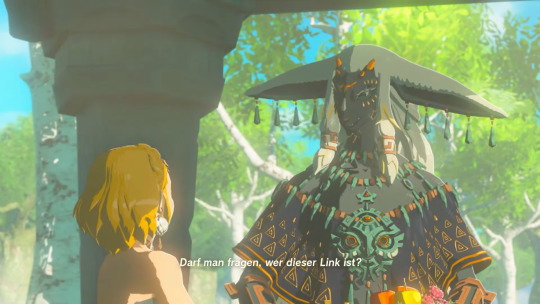
(Translation: May one ask who this Link is?)
Rauru definitely notices this too! His tone, as well as the use of the very specific article "dieser" ("this") indicate as much. If he was simply curious about who Link is in order to follow the conversation, he would more likely use the phrase "Darf ich fragen, wer Link ist?" ("May I ask who Link is?"). He is also teasing Zelda a little here.
Zelda's reply is also very sweet! While her first two lines are nothing special (she is essentially just recapping the events Breath of the Wild, as well as what led up to it), it gets interesting once Rauru reacts to her description, once again in a somewhat teasing manner (indicated by both the delivery and the language of the line):

(Translation: Oh, a hero you say.)
To which Zelda replies with:

(Translation: Link is the most steadfast and fearless knight who ever existed.)

(Translation: Yes...)
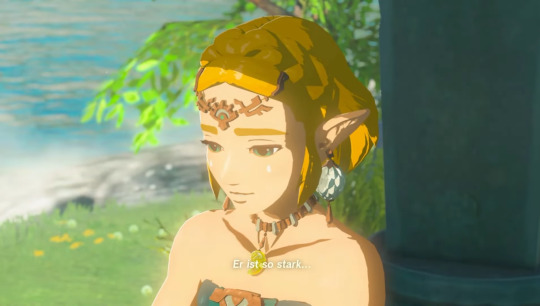
(Translation: He is so strong...)
That last line is pretty much the same in English, but Julia Casper (Zelda's German VA) does an amazing job making it sound like Zelda is not only admiring Link throughout this entire short monologue she is having, but like she is talking more to herself than to Rauru and Sonia, almost like she forgets they're there for a moment because she is thinking about Link. I really loved this little touch!
Also note that Zelda is not explicitly talking about physical strength in the last line (although she might be. It isn't clarified, leaving the interpretation of what kind of strength she is talking about up to the player).

(Translation: ... and on top of it all, he has a good heart!)
This last part seems to be directed at Rauru and Sonia again. But we're still not done!
After Rauru remarks that Zelda seems to think highly of Link and that the way she's talking about her knight makes him want to meet him, Sonia agrees and delivers a final line that, once again, makes it very clear that the two of them are engaging in a little bit of good-mannered teasing in this scene (both from what's actually said here and how Paulina Weiner delivers the line):

(Translation: Chivalrous, and full of gallantry...)
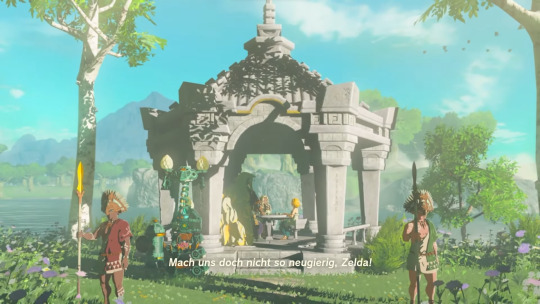
(Translation: Don't make us so curious, Zelda!)
And then they all break out in light-hearted laughter.
All in all, I really love this scene! Huge respect to the German VAs, who did an absolutely stellar job (not just in this scene, but for the game in general - especially Julia Casper!).
#The Legend of Zelda#Tears of the Kingdom#TotK#LoZ#Meta#Legend of Zelda#LoZ Meta#Analysis#LoZ Analysis#German#German dub#Zelink#Zelda#Sonia#Rauru#Currantlee here#Currantlee translating
2K notes
·
View notes
Text
Civilized Or Not
So there’s some common Zelda fanon I wanna talk about, relating to civilization tropes I think some of y’all haven’t really thought about in detail before, and that’s Hyrule (Zelda 1 &2 Link), Wild (BOTW mostly), and Ravio (LbW).
I’m using the Linked Universe names, because that’s where most of it comes up, because these things happen most often where you can contrast the boys with each other. This is often done, quick and dirty, by people assigning “roles” to each without much thought. Ravio’s unfortunately tends to be extremely pervasive outside LU spaces, too.
But, in brief, there is a trend for people to craft these characters in a framework of innocent vs savagery vs trickery that can have some really unfortunate implications I’m not sure many are even aware of. Hopefully I can explain better where these ideas come from, why they’re so easy and appealing, and why we should try to avoid repeating them for more than just the sake of “easy” but also to stop repeating some really nasty historical tropes.
I would start from what’s probably the simplest one to address: the tendency towards a “feral” personification of Wild. This tends to come from two places: Wild’s amnesia, and the collapse of society around him and his lost place in it.
Now, brain damage is complicated. You can lose a range of things to any given injury because of the way information is encoded differently and in different places. You can lose memory and/or skills and/or coordination and/or balance, etc, because it all depends on what got damaged. But in-game a lot of stuff suggests that Link retains things like speech, reading/writing, coordination, and martial skills. None of the people who knew Link prior to his injury suggest he seems changed in any way not attributed to stress and anxiety...
And, more importantly, real people suffer memory loss just like that in the real world. Treating him like he’s become “feral” due to memory loss is cruel to actual people living with brain damage today, and if you go there you should have a good reason for it.
Social collapse is a wide-spread theme in basically every Zelda game. The threat that the Big Bad poses is almost always the destruction of society as it exists: Malladus literally vanishes the infrastructure of New Hyrule in Spirit Tracks; the Twilight turns people into spirits living lives they don’t realize are questionably real in Twilight Princess; Veran freezes the passage of time to force people to work forever in Oracle of Ages. King Daphnes and Ganondorf under the sea vie over the fate of the world above in Wind Waker: keep what’s been made, or start all over again?
In modern culture, people tell a lot of stories about the fragility of civilization and what happens in its absence. You get the range from Lord of the Flies, in which children wrecked on an island attempt (and fail) to recreate civilization on their own, Kipling’s “The Jungle Book” in which Mowgli is treated as reckless and innocent, and a much more obscure piece from the 18th century “Paul et Virginie” (and likely many more I don’t know offhand.) Essentially all of them play with the question of how do people become civilized, and what happens when they do? In Lord of the Flies, the children were civilized and failed to maintain it; in the Jungle Book, the boy wasn’t civilized and innocently interacts with it. In Paul et Virginie, the children were (relatively) uncivilized on the (French colonized) Mauritius, raised by their mothers but when the girl was sent away, she becomes civilized and dies tragically to preserve it.
The two Links most removed from civilization are Hyrule and Wild. Wild “lost” civilization, losing both his memories of it and the structure of it. Making him feral, without manners, and without a place to belong is that kind of Lord of the Flies savagery mixed with Mowgli’s innocent playfulness: there isn’t a structure to adhere to, so he’s a savage. Whereas Hyrule is more like the Paul eg Virginie side: innocent of civilization, he remains pure and sweet and kind, unable to conceive of big concepts like evil or money or so on. Neither position permits them to interact with the civilization that is right there in front of them! Wild can buy a house; he has people who know and care for him. He has social connections and social rights. The world exists, but the fandom does not seem to want him to interact with it in favour of remaining “wild.” In Zelda 2 – a game explicitly set within a decade of Zelda 1 – there are whole towns with trade and a castle and massive structures with on-going life in them... but very few fans seem to ever reach into that story or relate it back to the first. Hyrule, the character, does not exist within Hyrule, the country.
Strangely, Wind Waker does not fall prey to this, I think because the structures are presented as fait accompli: Link wakes up with his grandmother and his sister, he has a defined home, and a society in which you spend the entire game forced to engage with. Zelda 1 & 2 were not sophisticated enough to waste resources on going as in depth in social terms (although such interactions absolutely exist in Zelda 2!) and BOTW leaves such interactions as optional: you can survive the game with minimal social contact... but it’s a choice to play with it that way, not the default. The ways in which this edges onto the noble savage trope, in which “uncivilized” tribes are either innocent or brutish (rather than complex social systems in their own right) is fairly obvious.
There is one other character in Zelda who gets treated to the question of whether he is an innocent, free of civilization and all its rigour... or something else. Ravio, coming from the devastated world of Lorule, can often wind up slotted into the scared, innocent child trope and unfortunately that’s the better position people frequently take. The worse one evokes the Merchant of Venice: the deceitful, Jewish merchant who values money over people’s lives.
Lorule (and Nintedo’s approach towards their humanoid Zelda villains in general) is near-eastern-coded in many ways, down to the fact that Yuga’s outfit is the spitting image of Ottoman dress. Yuga being a depraved bisexual (a common historical trope about Muslim men towards Christian men and boys), and Hilda being deceitful and conspiring against everyone she was once allied to are a backdrop to the ways in which Ravio is a greedy coward. He’s not an evil character in the game; the mechanic of penalizing death without being too severe is interesting and works well! But that doesn’t take away the stereotype, just like it’s not okay Nabooru is pretty explicitly predatory towards child Link in Ocarina of Time, too.
Arab and Jewish stereotypes often converge, because both people's originate from the same region, and both are hostile "Others" to Christian Europe and Nintendo doesn’t have a great track record of their near-Eastern coding in Zelda. It crosses the whole gamut from harem and amazon tropes with the Gerudo to breath-takingly anti-semitic or anti-black (Ganondorf being green, eg. non-human, in various incarnations), all packaged neatly in the ideal of medieval fantasy Europe. The scale would be impressive if it wasn’t so damn awful, but we can at least stop repeating it in our fanworks.
Wild doesn’t have to be feral to be a playful little shit; Hyrule doesn’t have to be pure and innocent to be kind. Ravio doesn’t need to be innocent or scheming, and he shouldn’t place money over Link’s well-being (If you chose to respawn at home, he is consistently only ever concerned for Link! Once you buy the items outright, he promises he'll still be there to take care of you.)
Do better. It’s more interesting that way, and I want to see that variety grow!
[If any of y'all would like me to dig up better sources on any point, I can do so but I didn't want to bog this post down further. I have largely left the anti-arab stuff alone because it's not the biggest issue with Ravio's fanon presence, which is the focus here.]
#Zelda Meta#Linked Universe#Ravio#LU Wild#LU Hyrule#antisemitism in media#noble savage tropes#bad tropes#Unfortunate implications#LOZ meta#LU meta#Long post#like 1200 words#I'm having a week okay#brain damage#mental illness
106 notes
·
View notes
Text
it's called Tears of the Kingdom not just because of what happened 100 years prior to BotW but because of all of it, the whole cycle, starting with Demise and Hylia and going on and on and on through Link and Zelda and Ganon, the inescapability of fate, the unending weight of duty, the constant injury done to Hyrule and its people over thousands of years, the cannibalizing nature of destruction where the kingdom of Hyrule is ground zero and is so worn and weary of this cycle that the land itself is breaking down and crying
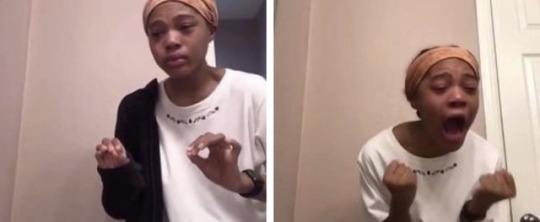
1K notes
·
View notes
Text
to solidify my point that it totally makes sense for Rauru to be the first king of this Era's Hyrule- here are the two other occasions Hyrule is destroyed and then re-established.
-BOTW/AOC, Hyrule is destroyed in the Calamity, while it's not necessarily re-established afterwards it is considered an ancient & lost kingdom in the eyes of locals.
-Wind Waker/The Phantom Duology, Hyrule is destroyed and is lying dormant under the great sea and is seen re-established in Spirit Tracks.
all I'm saying is that TOTK clearly doesn't retcon Skyward Sword from the timeline, it's plenty possible for the Zonai to exist and to have founded Hyrule as a kingdom.
#legend of zelda#loz#zelda#tloz#the legend of zelda#tears of the kingdom#totk#botw totk#loz totk#rauru#skyward sword#wind waker#phantom hourglass#spirit tracks#age of calamity#breath of the wild#legend of zelda meta#loz meta#discussion post
203 notes
·
View notes
Text
I feel like there's something to be said about how the Sheikah and the Gerudo are essentially two sides of the same coin.
This is how I see it: The Yiga Clan reflects the Gerudo from Ocarina of Time where both groups are ostracized and persecuted to a point where there is little room for compromise or coalition with the Royal Family. Hell, these people even live in the desert and are called thieves (which is just Hyrule's shorthand for "we've killed so many of them and left the rest to fend for themselves in a place that bears little to no resources needed for survival") just like the Gerudo.
And it's heartbreaking in a way, how Urbosa calls the Yiga members traitors instead of realizing she's looking at a mirror of what her people had once endured. Especially since the game heavily implies that her involvement as a Champion is largely characterized by her effort to try and redeem her tribe since the events of Ocarina of Time to the rest of Hyrule for something that was not even their fault.
Sure, there is no denying that Ganondorf was ultimately misguided in his conquest for power, but there's the part that goes unsaid where Demise ensured that his hatred would reincarnate, no? And well, hatred isn't mindless. It cannot exist without a trigger.
The Royal Family of Hyrule forced his hand, just like it forced the Sheikah's. And the sooner Urbosa could have realized that, then the sooner she would have understood why the Yiga were so hellbent on vengeance.
#maybe i'm just speaking out of my ass but#the poc in me always raises an eyebrow at the way the yiga is portrayed because like... they have every right to be mad lmao#and urbosa being the one to take shit personally about the yiga just seems... idk out of character?#like i get it you're protective of zelda but you're also the chief of your people think of the impact the hylian monarchy has on them#loz#legend of zelda#breath of the wild#ocarina of time#sheikah#yiga clan#gerudo#loz meta#urbosa#ganondorf#demise
267 notes
·
View notes
Text
Ive seen people be like "how on earth can they follow up botw and totk with another zelda game?" Which is fair, but those people seem to forget there are two sides to zelda. The very serious side, and the silly side. And Im not just talking about moments, Im talking about whole games. Botw and totk both leaned pretty heavily into the serious side, even though the link is probably one of our silliest yet.
So the only logical conclusion is that the next couple games should be the exact opposite.
Im talking like, triforce heroes and spirit tracks levels of chicanery. I need these next couple games to have game specific mechanics and themes so ridiculous that the game reviewing sites will pre-emptively call it stupid before its even out.
I need the world to be so silly and wacky that link almost feels like the straightman to a joke, but the whole thing is played so sincerely that it cant help but make you smile.
I need the villain to not be ganondorf; its either vaati, or the villain needs to be one of those one of single game villains made only for this specific setting of zelda, that fans will love and beg for more of and then never see again.
I need the technology to be weird and look oddly advanced with no explanation despite the fact every single character looks like they just came from the local ren faire.
I need the style to be toon link. We havent seen the lad outside of smash bros in nearly a decade. And not only do I need it to be toon link, I need the entire game to be stylized in a way that throws all the older zelda fans completely off like windwaker did. I want this to be the persona 5 of zelda games, so visually distinct it changes how all other toon link zeldas are shown in media by extension.
I need link to have a companion again, and they have to be the most annoying little shit. Im talking navi levels of annoying. But then the game makes you attached to them and sucker punches you at the end when you eventually have to part ways.
And I want another alternate world that I personally will be begging for more lore about, only to never see it again in the zelda franchise.
The only way to truly follow up a game that takes such dedication and respect to the previous iterations of the franchise while subverting many of the tropes you'd find in the games is to make a game so pack full of the tropes but so earnest about it you can't help but enjoy yourself. And the only way to really do that is to lean hard into silly Zelda.
#loz#loz meta#botw totk#totk#loz totk#loz tears of the kingdom#loz botw#botw#text post#oh and dont forget the game is also actually super emotional and has a very serious plot#its just it doesnt really acknowledge it in the mechanics or box art and it only comes up during the second act#bonus points if its literally just another four swords game almost 20 years after the last one#also bonus points if zelda is actually a character which is suprisingly common in toon link games#toon link
93 notes
·
View notes
Text
So You Want To Get Into The Legend of Zelda But Don't Know Where To Start: A Masterpost
this discussion came up in my zelda stream the other week so i thought since i'm a longtime fan and Extremely Normal i'd make a guide to people who are just now getting into the series because of breath of the wild/tears of the kingdom. there's a lot of games and it can be confusing on how they're connected, where to start, etc. this is going to be an EXTREMELY LONG guide, sorry - if you want a short version you can check out this post i wrote a long time ago.
The Timeline
so the good news is that the zelda games were published non-linearly, meaning that the game that takes place first chronologically was not necessarily the first one ever made. they didn't even HAVE a timeline until like 2011 or so. for that reason, with a few exceptions*, you can jump in pretty much wherever you like. most zelda games (or pairs of games*) are spaced hundreds or sometimes even thousands of years apart, featuring different links and zeldas and other characters, which means you don't need to know anything about zelda to start with any game. the series is deliberately made so that each title works perfectly well as a stand-alone game.
*the exception is that a very few games have direct sequels - for example, majora's mask takes places just a few years after ocarina of time, phantom hourglass takes place after wind waker, etc. luckily even with these games, you can still jump in without having played their other half and have a good time without getting lost.
The Introduction
that said, the zelda series is extremely eclectic. while they all have the undercurrent of "zeldaness" that makes them special they can be as different as night and day. 2D or 3D, happy or edgy, mainline or spinoff, story-heavy or story-light...which game is best for you to start with will depend heavily on your own personal tastes.
the short version: if you haven't yet, i recommend most people new to zelda start with either ocarina of time or breath of the wild. these games, released almost 20 years apart, were both completely revolutionary and redefined their genres (or, in oot's case, the entire industry). they usually have something to offer everyone and they're both games with standout tutorial sections that teach new players the lay of the land with ease. there's a reason most people start with one of these two - which one you prefer depends on whether you can enjoy an older game or would prefer something newer. for brand-new gamers, i might also recommend skyward sword because of how much the game holds your hand - it's frustrating for more experienced players, but for those just getting started in gaming in general it might actually work out well.
the long version: OBVIOUSLY i'm going to do a game-by-game write-up. sue me. if you're looking for information on a particular title, ctrl+f it. otherwise, settle in. time for a cut!
The Games
how to read this guide:
which games: most of them. this guide is long enough as it is, so i'm not doing a whole ass writeup for REALLY niche spin-offs like the tingle games, the crossbow training game, the bs releases, or the much-loathed cdi games, even if i think the crossbow game ruled. i will do hyrule warriors and cadence of hyrule because they're properly fleshed out games. ports and remakes are gonna get grouped together with the originals to save time and space. if there's something missing from this list you want to know about, the wikipedia article with the complete list of zelda media is right here and it's a genuinely fascinating read. have fun!!
release date: self-explanatory. using japanese release dates for overall accuracy, and the games are in order of release date as well, but you DO NOT need to play them in that order - that would be madness
console: original console, other consoles it's available on (not including the weird experimental stuff like satellaview, c'mon), and whether or not it is available for switch. why? the switch is the latest console, how many new fans got into zelda, and because of nso, it will be the easiest access point for people who can't or don't want to buy new consoles/emulate on pc. nso stands for "nintendo switch online," which is a the online membership you can purchase from nintendo. the basic plan allows, among other things, emulation nes, snes, and gameboy titles. the expansion pack tier adds emulation of n64, sega genesis, and gameboy advance titles. i think nso is a good service with great value if you can afford it - read about it here. virtual console is just buying the game, usually for a low price, and downloading it digitally to play on newer consoles, but most of those services have been shut down now. there's also backwards compatibility - the wii u can play wii games, the wii can play gcn games, the original ds (and ds lite) can play gameboy advance games, and the gameboy advance (and gameboy sp) can play gameboy and gameboy color games. the snes can also play gameboy and gameboy color games with the super gameboy, and the gcn can play gameboy, gameboy color, and gameboy advanced games with the gameboy player.
average playtime: this comes from howlongtobeat.com - if it seems off, take it up with them
mainline game: this just means whether or not this game was a "big entry" into the series - typically, mainline games are devloped by nintendo directly (though nintendo develops side-games too), and they have a higher budget and a longer dev time, but this doesn't necessarily mean they're better - some mainline games are received more poorly than the ones that aren't mainline. also sometimes people argue about which games count as mainline games so take it with a grain of salt
sequel: whether or not a game is directly tied to another game in the series - again, even if they are tied to another game, you don't HAVE to play that other game first
story-heavy: how many cutscenes/cinematics/character stuff is going on
edge level: how much grimdark and serious stuff is present and how "on-screen" it is. zelda games are infamous for a careful balance of cheerful and dark stuff in all games, but some games are more forthright about the darker elements than others. i prefer those, but you may prefer it the other way!
the premise/the good/the bad/the verdict: the actual write-up. unfortunately not even i have played/finished every zelda game (someday...), so for the games i can't speak on personally, i will make a note on it so you can seek a second opinion.
now let's get started!
The Legend of Zelda (1986)
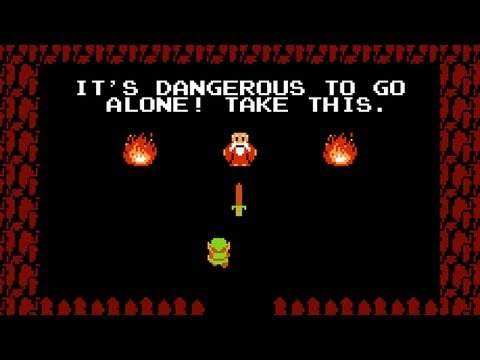
original console: nintendo entertainment system
available on switch: yes, with nso (basic)
also available on: gcn & gba (ports), gcn (gameboy player), wii, wii u, 3ds (virtual console), original ds (backwards compatibility), pc (emulation)
average playtime: 8-10 hours
mainline game: yes
sequel: no
story-heavy: no - in fact, for games in this era, reading the instruction manual is a must if you want story content; because the file size had to stay small, story content that couldn't fit was often added to manual instead
edge level: low
the premise: explore hyrule to find and put together eight fragments of the triforce so you can rescue princess zelda from ganon, prince of darkness.
the good: a solid introduction to the series, you can waste HOURS exploring this game, which is kind of a miracle considering the whole thing is only 128kb. (if you enjoy emulation, any computer will be able to play this. like doom, it could probably run on a microwave.) it's charming enough for when it was made and the music is all catchy as hell, even though it contains only a dozen or so tracks. this game is pretty light on puzzles, but most of the fun comes from the exploration - in fact, it was this game that the dev team for botw drew inspiration from when they were trying to figure out how to "reinvent" the zelda series - what they actually did was take it back to its roots.
the bad: well, it's that you can waste HOURS exploring in this game. back when it was released, the intent was to get players talking to one another - you would get one piece of the map explored and fine one secret, your friend would find and explore a different piece and find other secrets, and you'd trade! many people even had their own hand-drawn maps put together one screen at a time. since it really isn't possible to play this way today unless you get a bunch of friends together to do it blind, you almost certainly need a map or guide for this game when you're doing it on your own, otherwise you're never going to get anywhere, because there aren't usually indications that certain walls are bombable or bushes burnable.
the verdict: if you're a veteran who liked alttp (particularly the combat), if you have a high tolerance for aged games, or if you wanna see what this series looked like during its humble beginnings, you will like this game. if you're looking for a more guided experience or something with a lot of cinematics or puzzle-solving, pass. don't forget to read the manual!
Zelda II: The Adventure of Link (1987)
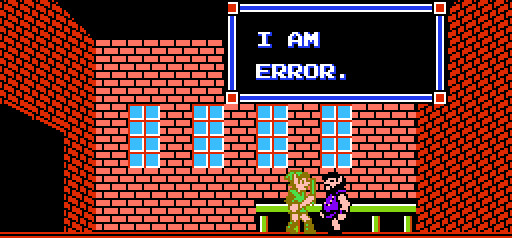
original console: nintendo entertainment system
available on switch: yes, with nso (basic)
also available on: gcn & gba (ports), gcn (gameboy player), wii, wii u, 3ds (virtual console), original ds (backwards compatibility), pc (emulation)
average playtime: 11 hours
mainline game: yes
sequel: yes, to the original legend of zelda
story-heavy: no - ditto for story being in the manual, like with the original loz
edge level: low
the premise: dive into six ancient palaces to place crystals there to wake princess zelda from an era long gone, who has been sleeping for hundreds of years. avoid being caught by ganon's minions, who want to use link's blood to revive their master ganon.
the good: because this game began life as an independent title which eventually got zelda-fied, it's quite different from most games in the series. it has side-scrolling combat and rpg elements. the soundtrack is very catchy, and this game also introduces dark link, an extremely cool popular doppelganger of our beloved hero. the map is HUGE in comparison to the original so there's tons more to explore here.
the bad: this game is HARD. not, "challenging," like, "bordering on impossible." i've never beaten it. i got just a couple of dungeons in and i was so miserable i had to give it up. even playing the "special edition" on nso (which is with all the unlockable upgrades to make it easier), it's a fucking slog. that's it! that's the only flaw.
the verdict: even with all its good qualities, even with how fresh it feels, it's so damn frustrating that only gluttons for punishment and very unique souls will truly find joy here. if you do decide to brave it, remember to read the instruction manual.
A Link to the Past (1991)
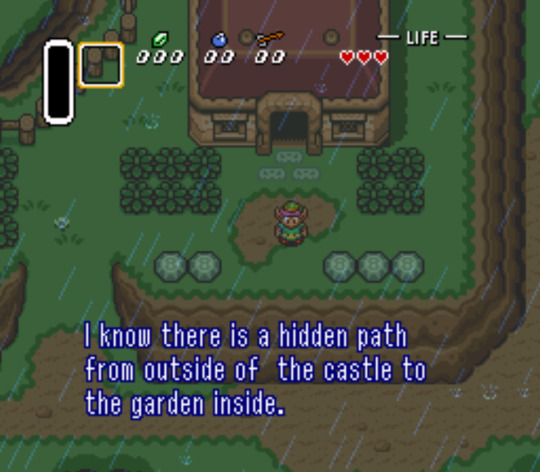
original console: super nintendo entertainment system
available on switch: yes, with nso (basic)
also available on: gba (port), gcn (gameboy player), wii, wii u, 3ds (virtual console), original ds (backwards compatibility), pc (emulation)
average playtime: 15-17 hours
mainline game: yes
sequel: no
story-heavy: medium. this was the first game to actually HAVE a proper story with named characters and extended dialogue. it wouldn't be considered story-heavy by today's standards, though.
edge level: medium, but like, on the high end of medium
the premise: one stormy night, link and his uncle receive a telepathic message from zelda begging for aid. link's uncle goes out into danger and doesn't return, so it's up to lik to go rescue her in his stead. from there you'll have to explore hyrule to locate the master sword, and explore the mysterious golden land behind the seal of the seven wise men to locate their missing descendants.
the good: alttp set the blueprint for the rest of the series - we finally have our first dungeon-crawler with proper puzzles, real dialogue from zelda, named bad guys, a huge array of funky items, and jammin' tunes still used in the games today (hyrule castle anyone?). plus, link has pink hair! the opening to this game is utterly iconic in every way, and traverse through not one but TWO world maps that overlay one another makes exploration even more exciting.
the bad: truly, no complaints here. it does require some patience. it's a little aged, and it's always possible to get lost without a guide, but so is it true for every game with a big overworld like zelda's.
the verdict: again, this game isn't story-heavy by today's standards, but back then it was more story than we'd ever gotten from a zelda game. as long as you don't go in expecting it to have an rpg kind of story, you'll probably enjoy it. if you don't like 2D zelda combat or need shiny graphics to keep your attention, give it a pass.
Link's Awakening (1993, 2019)
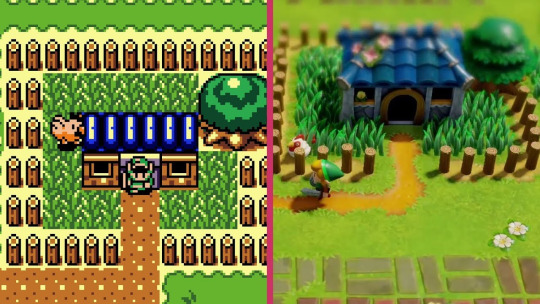
original console: gameboy/gameboy color, and a switch-exclusive remake
available on switch: yes - you can play the original with nso (basic) or the switch-exclusive remake
also available on: snes (super gameboy), gcn (gameboy player), gba, original ds (backwards compatibility), 3ds (virtual console), switch (remake), pc (emulation of any version)
average playtime: 14-19 hours for the original, 14-21 hours for the remake
mainline game: yes for the original, no for the remake, technically
sequel: technically a sequel to a link to the past, but they truly have nothing to do with each other
story-heavy: medium - similar story style to a link to the past. smaller cast and less overall dialogue, but more character work on marin specifically
edge level: usually pretty low, but in the rare moments when it jumps out it REALLY jumps out
the premise: while sailing, link becomes shipwrecked, washes up on shore of a remote place called koholint island, and is rescued by a girl named marin. with his boat in pieces, he has to go on a bittersweet adventure exploring the island and getting to know his rescuer in order to wake a mysterious being known as the windfish so he can go home.
the good: a tiny yet vast map, foreboding dungeons (hello, face shrine), a strange and quirky world that's impossible not to love with a small but charming cast to match (though, of course, the real stand-out character is marin), fun minigames, and a soundtrack that only got better in the remake. this game has it all! the story will surprise you by leaving you weeping at the end. there's not a huge difference to the gameplay between the original and the remake - it's mostly a graphical update, though they did add some side content.
the bad: it's one of those games that's different from the rest of the zelda series, which means it's not for everyone - there's no zelda, no ganondorf, no hyrule. also, getting the best ending is absolutely painstaking.
the verdict: what a wonderful game! the story is sparse but rewarding. if you don't like 2D zeldas, story-light games, or don't want to cry through the credits, you can give it a pass - but everyone else should love it.
Ocarina of Time (1998, 2011)

original console: nintendo 64, and a 3ds-exclusive remake
available on switch: yes, with nso (expansion pack)
also available on: gcn (port), wii, wii u (virtual console), 3ds (remake), pc (fan-port or emulation of either version)
average playtime: 25-40 hours
mainline game: yes
sequel: no
story-heavy: yes, medium-high. it wouldn't impress by today's standards but back then it WAS the standard
edge level: medium-high. it's horrifying in some respects, but overall very wistful and bittersweet
the premise: link, the local outcast, is ousted from his idyllic home after tragedy strikes in the form of ganondorf murdering his forest's guardian spirit. from there you'll explore hyrule to open an ancient doorway, and go on a time-traveling adventure in a last-ditch attempt to prevent a terrible future and heal a broken world that didn't always want you.
the good: what can i possibly say about ocarina of time that hasn't already been said? critically acclaimed as the best game of all time when it was made and still 25 years later (with only breath of the wild threatening to unseat it), this game is everything. this is the game that taught me to love stories, to love gaming, to love zelda. the world is full of secrets and places to explore, there's a kind of dual-overworld thing happening the way there was in alttp, there's a lot of collectibles and sidequests and TONS of minigames, there's a huge cast of characters with real depth, you can RIDE A HORSE, and the quite literal coming-of-age story has actual plot twists that affect the gameplay. this game defined the official timeline for zelda (massive spoilers at the link), it defined the series itself, it defined the genre and even the industry - games everywhere are still using concepts introduced (or made popular) here, like targeting enemies, context-sensitive buttons, dynamic soundtracks, and day-night cycles.
the bad: one of the dungeons is a shitty goddamn motherfucking royal pain in the ass. you know what i'm talking about. unless you don't, in which case i'm sorry. maybe it's less horrible in master mode, i don't know. also, like, it's not that the game has aged poorly, it's still a solid adventure, but it HAS aged. since basically every game you've ever played has emulated oot with stuff like lock-on targeting, these features won't feel as revolutionary and special to a new player today as they did to new players in 1998. that's not bad, but it has caused some people to get excited to look into the hype, pop the game in, and then go "wait, i don't get it."
the verdict: unless you absolutely cannot deal with playing a 25yo game, pick this up - for the historical value, if nothing else. i cannot more highly recommend any game that ever existed than i do this one. that said, for people who are new to GAMES IN GENERAL, it may not feel as intuitive as it did to new players in 1998, because speak a slightly different language now. new gamers should definitely still play this, but they should either use a guide or consider not making it their very first game. more experienced gamers should still be fine making this their first zelda game.
bonus verdict: as for which console to play it on - the 3ds version has a lot of quality of life adjustments, including gyroscopic controls and a master mode (gcn version also has master mode), and the graphical improvement is absolutely astounding...but it's on a teeny-tiny little screen. i think the best way to play ocarina of time, if you're able to, is to emulate the 3ds version with the fanmade 4k upgrade. of course, this requires a good pc, emulation skills, and a properly connected controller (i haven't done it yet myself) - so don't feel bad playing anyway you can access it.
Majora's Mask (2000, 2015)

original console: nintendo 64, and a 3ds-exclusive remake
available on switch: yes, with nso (expansion pack)
also available on: gcn (port), wii, wii u (virtual console), 3ds (remake), pc (emulation)
average playtime: 20-38 hours
mainline game: yes
sequel: yes, it's a direct sequel to oot. the opening may be a little confusing if you haven't played it but otherwise you're fine
story-heavy: yes, VERY. the character-work alone is unparalleled even by modern standards
edge level: EXTREMELY HIGH. this is without a doubt the darkest and most haunting game in the series
the premise: link, trying to escape his problems back home, gets thrown into an unfamiliar world where the moon is going to fall and destroy everything in only three days. with the help of multiple forms (link can shift into a deku, goron, or zora), and time travel, link relives the same three days over and over again, exploring clock town and the lands around it, and getting to know its people, so he can find a way to help everyone and prevent the oncoming apocalypse.
the good: holy cast of characters, batman! as with every zelda game, there is exploration and dungeon-crawling, and these are phenomenal here - of particular note is how the use of 4 different forms plays into puzzle-solving - but the real meat of this game comes from its incredible cast. near the beginning of the game you are given a journal, in which to note the schedules and habits of each and every resident of termina as you learn them. you play the same three days over and over, so while the clock is always ticking, there's an infinite time to get to know them. each character reacts to the upcoming armageddon differently: some are resigned, some are frightened, some are brave, and some are in denial. (notably, one minor character who appears brave crumbles in the final hours, begging not to die.) who these people are and the sorrows they carry around with them to the end of the world define this game and make it like no other.
the bad: look, it's a game about an upcoming apocalypse. you're on the sinking titanic and the clock counts down every precious second and no matter what you do there will ALWAYS be that time limit, which not everyone likes. it's stressful, and it can be sad and tragic, even upsetting at times, which is kind of a requirement for the powerful catharsis it also offers. it's very different to the usual zeldas - no zelda or ganondorf or hyrule - which also isn't everyone's bag. it's also a huge timesink - you really miss a lot of the point if you don't 100% it or at least get all of the masks, which takes a long time and a guide (although it is fun as hell the whole time).
the verdict: some people really hate the time limit and find it imposing. i mostly don't have a problem with it - sometimes i have to race to finish a task before i run out of time so i HAVE time to travel back before i get blown to bits, but without this mechanic, the game wouldn't work at all. famously, this game was made in only one year (hence the reused assets), so the pressure the devs felt really came out in their work. i think it's a fucking masterpiece, but it is a game about death, among other things, so if you need a feel-good title this one probably isn't your stop. that said, the incredibly powerful cast makes this game timeless - if not for the graphics you'd hardly know it's aged at all. even newer gamers should enjoy this one, but use a guide! for a game this complex it's more important to find everything than it is to do it blind.
bonus verdict: while the graphical improvements on the 3ds are wonderful, and the added fishing minigame is great, i mostly preferred the controls of the original. new players may not notice the difference, though!
Oracles of Ages & Oracle of Seasons (2001)
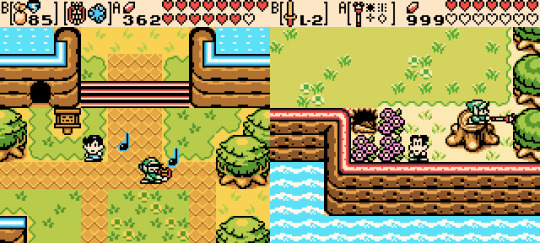
original console: gameboy color
available on switch: not at the time of writing, but nintendo has confirmed it is coming to nso (basic)
also available on: snes (super gameboy), gcn (gameboy player), gba, original ds (backwards compatibility), 3ds (virtual console), pc (emulation)
average playtime: 16-25 for oracle of ages, 15-21 for oracle of seasons, leading to about 31-46 hours total
mainline game: no
sequel: not linked to any other games in the series, but they're technically both sequels to each othjer - more below
story-heavy: no, about medium-low
edge level: low
the premise: link hears the triforce calling out to him, and when he investigates, is thrown into one of two words, depending on which game you're playing. these two games stand alone, but they can also be linked via a code so that your playthrough on one can be transferred over to the other (like golden sun, if you've ever played those games). you can choose which game to play first. at the end of your playthrough, you can get a code, which can then be entered on the other game - complete both and you get a secret special grand finale. somewhat like pokemon games, the games complement each other in their differences, thoguh the differences here are much more drastic - they have different overworlds and dungeons, a slightly different set of items, and a different way of interacting with the world (by either traveling through the ages or by changing the season). oracle of ages is focused on puzzle-solving, while oracle of seasons is focused on combat and action.
the good: what a dense and detailed little adventure these games are! with a double of everything from items sets to overworlds, there's a ton to do. the worlds have a ton of variety and can feel endless at times. and since they were built on (i think) the link's awakening engine, gameplaywise it's kind of like getting to play a really good sequel to that game for the first time...twice. the lore is fun, the lands are fun, there's a couple of unforgettable tracks i still listen to. since you can play the games in either order, there's a good bit of REplayability involved, because hardcore fans will want to experience it both ways - leading to two playthroughs of each game, meaning four total playthroughs, for up to a whopping total of 92 hours of gameplay. talk about bang for your buck!
the bad: the codes are a real pain in the ass to work with, and you really can't get by without them. not only is it essential for moving your file from one game to the other, but you can also use them to get special items from one file to another. it's SO EASY to enter these codes in wrong and SO TEDIOUS to have to check them character by character. here's hoping the nso version has a better way (though i'm not holding my breath).
the verdict: an absolute must for any 2d zelda fan. first-time players, i HIGHLY recommending playing ages first. there's an important side-character in ages whose story gets resolved in seasons, but not if you play seasons first. of course, if you really like the games a lot, you can always start over and play them in the other order for different cutscenes.
Wind Waker (2002)
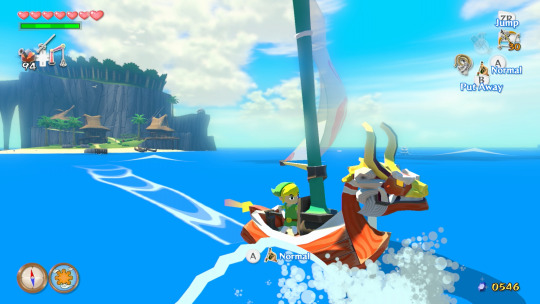
original console: gamecube
available on switch: no :(
also available on: wii u (hd port), pc (emulation)
average playtime: 25-60 hours
mainline game: yes
sequel: technically, this is one POSSIBLE sequel to ocarina of time (which splintered the timeline, leading to multiple possible branching paths), though it takes place hundreds of years later. it has the same ganondorf from that game, but you should understand everything just fine whether you've played oot or not.
story-heavy: yes
edge level: medium-low - there are some more serious moments, and this is technically a post-apocalypse story, but overall this is one of the more bright and joyful games
the premise: this is a hyrule that was flooded by the gods when the hero of an ancient era could not show up to defeat ganondorf. people live on former mountaintops, now islands, interconnected by only the sea, and sailing is very dangerous. when link's younger sister is kidnapped, he has to leave his little island and go on a sea-faring adventure with pirates in order to get her back and unlock the mysteries of the hyrule beneath the waves.
the good: the game is vibrant, colorful, beautiful, and full of life. even if you don't like the cartoony art style (and i have mixed feelings), you can't deny the ambiance. there's a new combat system where for the first time you can pick up the dropped weapons of enemies, and the cast is stand-out - the "zelda" of this game is more hands-on than in any other title, and ganondorf is at his most sympathetic here, not to mention all the minor characters and their various sidequests. the characters are truly some of the funniest and most endearing yet - this game will make you laugh out loud. the enemies and bosses are unique and fun to grapple with (special shoutout to helmaroc king) and there's no shortage of stuff to do.
the bad: firstly, we have to mention the art style, which has been a little divisive over the years. it won't be for everybody. i like it for the most part, because you couldn't get the same vibe without it, but i do wish it was just a little less stylized - just a little! secondly, the game is just not finished. the development was rushed, leading to the cutting of an entire dungeon and a poorly-implemented second half where the focus shifts from exploration and dungeons to a near-ENDLESS fetch-quest for triforce pieces which involves a LOT of incredibly tedious and time-consuming sailing. (as kids, some trips were so long we could just set the direction and leave the controller on the floor while we took a bathroom break.)
the verdict: overall, the flaws aren't enough to ruin what is a truly great adventure. fans of the more serious games (hi! me!) may find themselves wishing wind waker had leaned into its post-apocalyptic setting and mysterious drowned world aspect more, and fans of lighter zeldas will find themselves wishing the damn thing was finished, but overall, everyone should find it's worth at least one playthrough, unless you absolutely cannot tolerate the visuals. fans of lighter zeldas, combat, and pirates will all love this one.
Four Swords (2002)
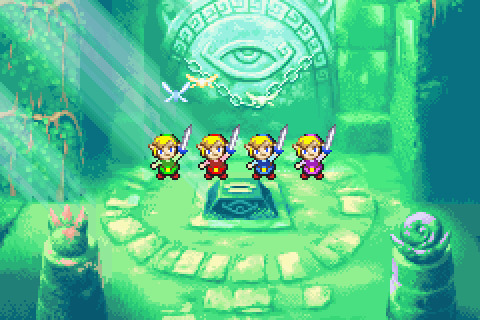
original console: gameboy advance
available on switch: no :(
also available on: 3ds (single-player remake), potentially pc (idk if emulation of the original is possible considering the connectivity, but you could almost certainly emulate the remake)
average playtime: 3-17 hours
mainline game: no
sequel: technically, it's a sequel to minish cap, but minish cap hadn't been made yet, so whatever
story-heavy: not at all
edge level: non-existent
the premise: link pulls the ancient "four sword" in order to defeat bad guy vaati and becomes split into 4 selves. this game was the first multiplayer zelda, and you had to have three friends, all with their own gameboys and link cables, to even play this bad boy. from what i understand in most of the game you just compete to see who can get the most rupees? a single-player version was released on the 3ds a few years later but i don't know if you can still buy it legit or if the 3ds store was shut down. since it was so inaccessible, pretty much no one played this, including me, so i can't give it a proper writeup. probably nobody reading this will ever get a chance to experience four swords how it was originally meant to be played either, but you can find this game's spirit in similar titles like four swords adventures or minish cap, which are much more accessible.
Four Swords Adventures (2004)

original console: gamecube
available on switch: no :(
also available on: uh yeah that's it. just the gamecube. you may be able to emulate it on pc though - i've never tried
average playtime: 15 hours
mainline game: no
sequel: teeechnically a sequel to the original four swords, but nobody played that, it's fine
story-heavy: not at all
edge level: very low
the premise: a sequel to four swords, this was intended to be the sleeker and (somewhat...) more accessible version. you can play this one as a single player, but my brother and i did it on co-op with a link cable and a gameboy sp - just the two of us, and no need to find two other friends - we each controlled two links each, to simplify it.
the good: the game is FUNNN as hell. the graphics are sleek as fuck because it's a 2d game running on a system capable of rendering 3d ones (just look at those flame effects!), the gameplay is addictive, and co-op puzzles are a blast. nintendo has always come out strong when it comes to in-person multiplayer (even if they have yet to catch up with online multiplayer...) and this is no exception. for anyone who ever wished they could sit on the floor and play zelda with their siblings the same way they played mario kart or smash bros, this game is a dream come true.
the bad: this game is still so GODDAMN inaccessible. we were lucky enough to have the gameboys and link cables we needed, but i don't have any idea how you'd go about playing it with other people now without some extremely tedious emulation or buying some extremely old (and expensive) gaming equipment. sure, emulating the single-player version on gcn is no big, but the game really shines in its multiplayer aspect, which is all but impossible for most people to enjoy now. it's incredibly frustrating.
the verdict: if you're lucky or rich enough to own a gamecube, a gameboy, and a link cable (multiple gameboys and link cables?) in 2023, AND you have a friend or three to play it with, please pick this one up. unless you just hate 2d zeldas, it is a FUCKING blast, and zelda fans the world over are probably envious they can't experience it for themselves.
Minish Cap (2004)

original console: gameboy advance
available on switch: yes, with nso (expansion pack)
also available on: original ds (backwards compatibility), 3ds, wii u (virtual console)
average playtime: 15-27 hours
mainline game: no
sequel: no, but it is a prequel to the four sword series (made well after those games were released)
story-heavy: medium-light - about the level of most 2d zelda games
edge level: very low - this is such a bright and cheerful adventure
the premise: in an adventure meant to explain vaati of four sword fame's origins, you meet teeny-tiny people known as the minish, who live in teeny-tiny spaces all over hyrule. they mend shoes, use pots and old boots as houses, fight dust mites, and leave surprise gifts such as rupees and hearts beneath pots and the like to help adventurers. by shrinking and growing you explore various nooks and crannies and solve a ton of puzzles, and through fusing items called kinstones with strangers you can change or uncover more of the overworld and unlock even more secrets
the good: the game is beautiful, bright, and fun. the soundtrack is catchy, the gameplay is addictive, the puzzles are very fresh, and the kinstone fusion feature means you'll be doing a lot of backtracking and replaying to see all this game has to offer.
the bad: besides zelda, i didn't find myself terribly enthralled with most of the cast. the reused sound effects from other games can be nostalgic sometimes but sometimes they feel a bit cheap, since they had to be downsized; they're the audio equivalent of a pixelated jpg. and as great as the soundtrack is, it suffered from the same thing.
the verdict: my nitpicks with this game are minor - i think it's a wonderful and fresh entry into the series, and probably one of if not the best 2D zelda. if you like 2D zelda at all, you'll want to pick it up.
Twilight Princess (2006)
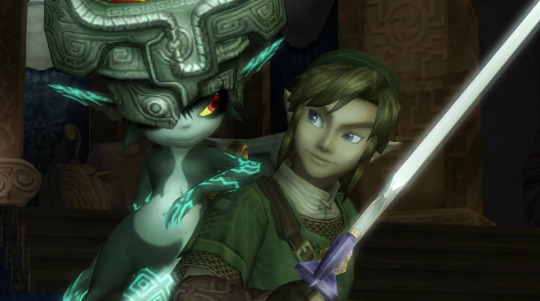
original console: gamecube AND wii (i know)
available on switch: no :(
also available on: wii u (hd port), pc (emulation)
average playtime: 30-56 hours
mainline game: yes
sequel: technically, this is another possible sequel to oot, taking place 100 years later, and involving oot's ganondorf. (it has nothing to do with the timeline wind waker is on.)
story-heavy: yes, very - the cutscenes look great, the mocap for this game is wonderful
edge level: very high
the premise: 100 years after ocarina of time, darkness falls across hyrule in the form of "twilight," desolating every part of hyrule that it touches by turning its denizens into ghosts, and forcing princess zelda to surrender to zant, the king of the twilight realm. when link's village is destroyed by this twilight and he is turned into a wolf, he leaves to save zelda, save hyrule, and save his home. this game was meant to be a gcn title originally, but development was delayed for so long that they began co-developing it for the wii and released it as a launch title for that console.
the good: where do i start? this game was intended to be a return to oot's more realistic artstyle after many years of the wind waker art style in spin-off games, and was in fact a spiritual remake of oot in many ways. it is similar graphically, tonally, and gameplay wise - it's the oot they wanted to make in 1998, only with a more powerful engine, and fans loved it - check out this video of its announcement at e3 - it still gives me chills. famously, this game introduced horseback combat, which the devs had really wanted to implement in oot and were forced to give up on due to hardware limitations. the cast and the puzzles are all great on this one, and the world is huge and full of surprises, but of particular note is your partner midna, who comes with a better story and more personality than any partner before or since (sorry, king of red lions). lesbians and their associates will LOVE whatever the hell she has going on with zelda in this game. twilight princess also has the most fleshed-out swordplay of any zelda game - the various techniques you learn from the ghost swordsman are fun as hell, and every single boss battle in this game absolutely fucks.
the bad: despite its high moments, the story in this game is just a little weirdly paced. ganondorf was brought in kind of suddenly, and link's childhood friend from his village, whom the story focuses on a lot, is maybe not the most compelling character (sorry to ilia fans - she's okay, just not my favorite). not everybody liked this game's emulation of oot, and some people felt it was uninspired. personally, my gripes are mostly about the dual-console release; having played both versions multiple times, i think they both suffered from being co-developed. because the wii version uses motion controls and most people are right-handed they switched to a right-handed link for the wii (BLASPHEMY), meaning they actually flipped the entire world horizontally, and there are times when the laziness of this action is very apparent when playing the wii version. while the controls are superior on the wii (there's a mandatory shooting minigame that's all but impossible on gcn connected to a crt tv), the graphics just...look a little aged for a wii game, whereas they look damn good for a gamecube game. the hd remake fixes this, but since it's only on the wii u, fucking nobody has played it, and it remains inaccessible to most players except through emulation.
the verdict: if you can get your hands on this, do it. despite its flaws it's a classic meat-and-potatoes zelda adventure. fans of combat and more serious stories will especially love this one. personally, i preferred the gcn version because of left-handed link, but i do think the motion aiming on the wii (and wii u?) was a great addition, so it's a matter of preference as far as if you want the hd graphics and what controller feels correct in your hands.
Phantom Hourglass (2007)

original console: nintendo ds
available on switch: no :(
also available on: wii u (virtual console), pc (emulation)
average playtime: 17-31 hours
mainline game: no
sequel: a direct sequel to wind waker - not sure if you need to have played that to understand; from what i can tell there are actually a few plotholes
story-heavy: medium, i think?
edge level: low, as far as i know
the premise: after tetra gets sucked into a ghost shiop ad vanishes, link has to set sail on a new ship to find a way to free her. that's all i really know because, okay, up-front, i did not finish it. i did not give it a fair shake. it's got great reviews and they can't all be wrong, but i found controlling link with a stylus (the ds had no control stick) frustrating, the game hard to see (the graphics are trying to emulate ww's style on less capable hardware), and the story uncompelling (tetra? a damsel??). i know a lot of people really love linebeck and i wanna love him too one day, but until then, get your answers from the people who love this game!
Spirit Tracks (2009)

original console: nintendo ds
available on switch: no :(
also available on: wii u (virtual console), pc (emulation)
average playtime: 20-33 hours
mainline game: no
sequel: to wind waker and phantom hourglass, technically, though it takes place 100 years after those games
story-heavy: medium, i think?
edge level: low, as far as i know
the premise: 100 years after wind waker and phantom hourglass, a new hyrule has been founded above the waves and it has TRAINS. for some reason zelda gets zapped out of her body and can now follow you around as a cool ghost who possesses bigass statues to help you out. that's right, your partner for this game IS ZELDA. the main theme for this game is so catchy it's a crime. i never played this since i didn't finish phantom hourglass, but it looks so fucking cool that i wanna power through phantom hourglass despite my initial reservations just so i can take a crack at it.
Skyward Sword (2011)
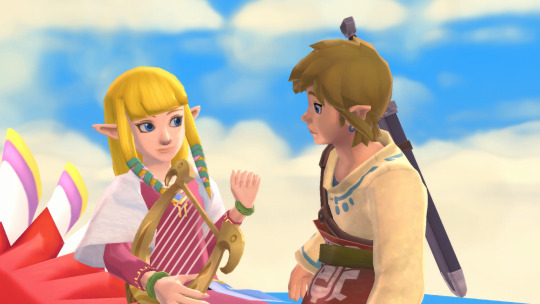
original console: wii
available on switch: yes, as an hd port
also available on: wii u (virtual console & backwards compatibility), pc (emulation)
average playtime: 30-58
mainline game: yes
sequel: no - in fact, it's the prequel to every zelda, being that it's the very first one in the timeline
story-heavy: yes, very
edge level: mostly low, but it does have its serious moments
the premise: taking place at the very start of zelda's long and complex timeline, this game seeks to explain the origins of hyrule's creation and and some of its mythology. link and the other proto-hylians live in islands high above the clouds and attend the school for flying around on bigass birds, not knowing if there even is a world below, until one day zelda (not a princess but the headmaster's daughter) gets dragged down by a dark force, and link must venture into the land below to save her.
the good: skyward sword is oozing ambiance. a standout area of this game is lanayru desert, in which you can use a timeshift stone to shift the area directly around you back in time by 1000 years or so and watch it come to life with greenery. this soundtrack is fully orchestrated, we get to hear zelda sing (her first voice acting debut!), and when the motion controls are on, they're REALLY on. sometimes the swordfights feel like actual duels. the cast of side-characters all get a lot of development (shoutout to my man groose!), and the villains are creepy and quirky. the dungeons in skyward sword are especially good - the cistern in particular is one of the best in the game, but we can't forget the ghost ship or the sky temple either. minor spoilers for the story, here, but finding out WHY there are so many zelda games and the struggle against evil never ends (it's a literal curse) was really cool and really reframed how a lot of people saw the series and the characters - it's a lot more tragic that they have a fate they can't escape from so long as zelda fans want more games.
the bad: minor spoilers for the story here too. as far as prequels go it did not make a lot of sense. there's nothing about the three goddesses we've come to know and love, only about the minor goddess hylia, and the ancient hyrule features species that don't ever make another appearance mole guys and seahorse dudes. there aren't any zoras or gerudo or koroks/kokiri, there's only one goron, we only see two sheikah...it feels so far removed from the hyrule we know that it doesn't feel like a prequel at all. additionally, when the motion controls aren't good, they're REALLY bad - especially on the switch version, which has less precise controls than the wii. finally, while i personally didn't mind it (puzzles!), a lot of people disliked how linear the overworld was and complained there was no exploration. another common frustration, one which i share, is how much the game holds your hand. (this famously inspired toriel in the game undertale to LITERALLY hold your hand and do the puzzle for you.) this game will present a puzzle and then have the nearest npc (most often fi, poor fi, she undeservedly gets all the blame for this) explain how to do it before giving you even one chance to try for yourself.
the verdict: it has its flaws, but i still enjoy it a lot. i think more experienced players will be very frustrated with it at times, and people who hate motion mechanics or constant alerts/lots of useless dialogue will be miserable. (you can turn motion controls off in the switch version but it feels unnatural because of how sword-swinging works.) on the other hand, the game's linear and hand-holdy nature actually makes it a perfect start for brand new gamers, especially given where it falls on the timeline.
A Link Between Worlds (2013)

original console: 3ds
available on switch: no :(
also available on: pc (emulation)
average playtime: 16-23 hours
mainline game: no
sequel: takes place at least 100 years after a link to the past, and even uses the same overworld! you don't have to play that to understand this though.
story-heavy: medium, about the level you expect for 2d zeldas
edge level: medium-high
the premise: link turns into a little flat guy so he can go more places! this is a sequel involving the inhabitants of lorule, a parallel world to hyrule, one without a triforce. go back and forth between kingdoms to save hyrule from suffering the same fate, all while trying to kick a giant rabbit guy out of your house.
the good: the puzzles in this one are really fun and fresh, the old overworld map feels super nostalgic, the music is charming, and being able to tackle the dungeons in any order is a nice touch. i especially loved getting to know certain inhabitants of lorule.
the bad: the non-linear style won't be for everyone, and i wish i had been able to spend more time getting to know hilda in particular.
the verdict: this in my opinion is one of the best 2D zeldas - if you're a 2D zelda fan, especially a alttp fan, don't miss it!
Hyrule Warriors (2014, 2016, 2018)
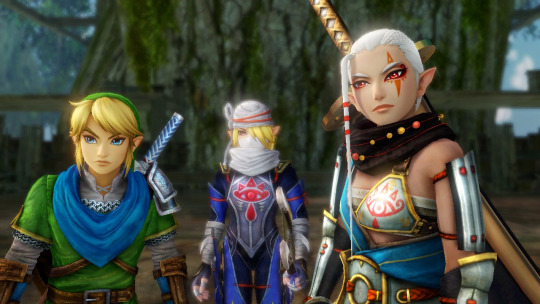
original console: wii u
available on switch: yes, as a remake/collection
also available on: this is complicated. the game was originally released on wii u, then ported to the 3ds with new added content but i think mising some other content, and then FINALLY released on the switch with ALL the content. you can also emulate any version on the pc
average playtime: 17-38 hours, though people report up to a whopping 366 hours to 100% it
mainline game: no
sequel: no
story-heavy: medium-ish. there's cool cutscenes but it's not that deep
edge level: low, this shit is just balls to the wall crazy-ass fun
the premise: a crossover between dynasty warriors and zelda. turn zelda into a beat-em-up and add cameos from popular characters doing increasingly batshit anime fighting moves. what's not to like?
the good: this game is insane. the electric guitar soundtrack, the cameos, the nostaliga - it's all here. the gameplay is good mindless fun you can really sink your teeth into, and despite it not being the point i had fun running around and exploring all the maps. there's so, so, SO much to do (366 hours!) you will literally never see the end of it.
the bad: the OCs are maybe not my favorite people. i don't know if they come from other dynasty warriors games but they were a little annoying and truly, uh, underdressed. also, as someone who likes to 100% games, it annoys me that i'll likely never 100% this, just because of the sheer timesink/grinding required.
the verdict: if you like fighting games and combat, this is for you. if you're into zelda for the serious story stuff and the puzzles, give it a pass. completionists beware, 100%ing this game is NOT for the faint-hearted.
Tri Force Heroes (2015)

original console: 3ds
available on switch: no :(
also available on: pc (emulation)
average playtime: 14-26 hours, but up to 56 hours to 100% it
mainline game: no
sequel: takes place a few years after a link between worlds - not sure if you need to play that to understand this, but it seems unlikely
story-heavy: doesn't look like it
edge level: low. oh my god, he's in a little cheerleader outfit. look at him
the premise: i don't really know, i think you crossdress to gain superpowers and then solve puzzles with your buds. i didn't play this one because i didn't have 2 friends with a 3ds and a flexible schedule. apparently there's a one-player mode, but it just doesn't seem as fun, and the lack of a 2-player mode is sad because my brother and i could've rocked it. like the four swords series, this looks like great multiplayer fun, but it's inaccessible to people without the time or coordination to get 3 people together. it looks fun as hell, though.
Breath of the Wild (2017)
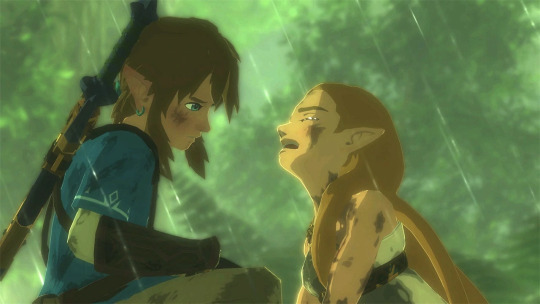
original console: dual launch on wii u and switch
available on switch: yes, obviously :)
also available on: pc (emulation)
average playtime: 50-100 hours, though to 100% everything and enjoy the dlc it could take up to 210!
mainline game: yes
sequel: technically, it's a sequel to everything, since it takes place at the end of (somehow) every timeline. but you don't have to have any prior experience to enjoy it
story-heavy: medium-heavy? this is the first zelda game with voice acting, and what cutscenes it does have are amazing, but you can expect to see only a very few of them
edge level: very high (this is once again post-apocalyptic), but not as high as majora's mask or twilight princess
the premise: link wakes after a 100 year sleep with no memory of who he is or what happened to the ruined world around him. explore a completely open world in your own way at your own pace, recover your memories, rescue zelda.
the good: this game hit the industry at a thousand miles per hour and six years later the hype still hasn't slowed down. this redefined the series and the genre in a way we haven't seen since oot in 1998. this game is revolutionary in the way that oot was revolutionary back then, but updated so that newer players find it just as surprising and refreshing as new players in 1998 found oot back then. the exploration, the physics, and the world are all totally unparalleled - three decades later, this zelda truly gets back to the original explorer and adventuring spirit miyamoto tried so hard to capture in the very first legend of zelda game all the way back in 1986.
the bad: as much fun as this world is to play around in, i found that most of my joy came from the exploration and not knowing what i'd find around the next corner. it's still a very, very, VERY good game, but i found that on my replay it just didn't have that same shininess that other games in the series do when i replay them. and, of course, because it's so different it's very divisive - there's no human ganondorf in this game, no dungeons - all your puzzle-solving comes in microdungeons called shrines scattered around hyrule. weapon durability is also a hotly debated feature - even i found it frustrating at times, although in many ways the forced improvisation it brings to the table is more than worth the cost of admission. and overall the enemies are all the same and have no real difference between them, even the bosses, and the boss fights kind of suck. it's a really good game, but it does have its flaws.
the verdict: this is the perfect starting point for anyone new to the series. many people have started with this game and learned about hyrule alongside the amnesiac link - i had an extremely interesting discussion once with someone on tumblr about how the game is different if you've grown up loving hyrule and see it get torn apart, vs if the only hyrule you know IS the one that's torn apart. both ways are wonderful experiences, and i think even non-zelda fans would find something to love in the freedom this game offers.
Cadence of Hyrule (2019)
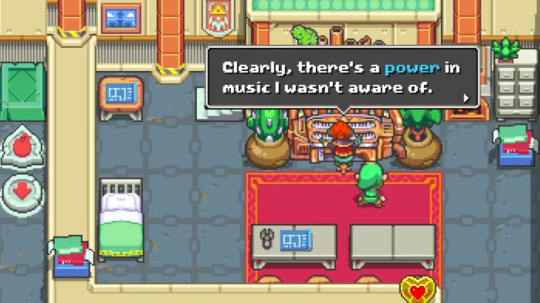
original console: switch
available on switch: yes, obviously :)
also available on: pc (emulation)
average playtime: 6-11 hours, but you can add up to 12 more if you play the dlc
mainline game: no
sequel: no
story-heavy: not really
edge level: low
the premise: a crossover with crypt of the necrodancer, a roguelike rhythm game. there's no real story here except, notably, a brief cameo of a younger ganondorf, though his back is always turned to you. (if you could go back and kill ganondorf as a baby...)
the good: well, a rhythm game's gotta have good music, right? both the rehashes of the old songs and the new music are absolutely stellar here. i'm normally iffy on rhythm games but i found the gameplay addictive (there's a strong tactical element to moving around) and the exploration fun. getting to play as zelda (!!!) if you want is a great bonus, too. there's really nothing not to love.
the bad: the kind of movement you have in this game doesn't lend itself super well to boss fights most of the time. they weren't bad by any means but definitely one of the weaker parts of the experience.
the verdict: unless you hate rhythm games or hate fun, you'll like this one, especially if you're a crypt of the necrodancer fan or a fan of zelda's music in general. puzzle fans might be disappointed there aren't as many mind-twisters in this one, though.
Hyrule Warriors: Age of Calamity (2020)
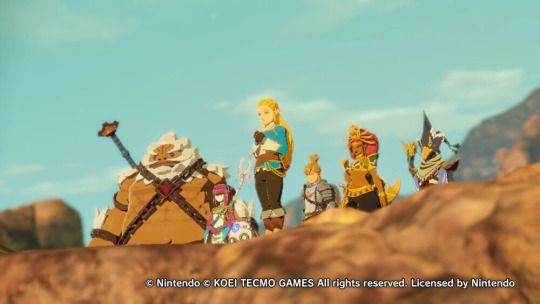
original console: switch
available on switch: yes, obviously :)
also available on: pc (emulation)
average playtime: 25-40 hours, though it can take up to 76 hours to 100% it
mainline game: no
sequel: a direct prequel to breath of the wild and its eventual but as-of-yet unreleased sequel tears of the kingdom
story-heavy: yes
edge level: relatively low, i'm told
the premise: so this is a prequel to botw, taking place during the era just before the apocalypse. i didn't finish it because it came out right around nov 5 2020 (iykyk) and then someone spoiled the ending for me and i thought it sounded stupid, so i was less motivated to play. what little i did play of it was great, though - it was exciting and fun in all the ways the original hyrule warriors was but bigger and badder in every respect, and with a little more of that somber botw flavor. i intend to finish before totk comes out despite my reservations about the story.
The Conclusion
it's a great time to be a zelda fan because out of the 22 games on this list, only 8 of them are unavailable on nintendo switch, and only 2 of those are what i would consider to be mainline games. that means you can access two thirds of the ENTIRE SERIES, spanning almost 4 decades, on a single console! your only limits are your time and your wallet. most of the ones that AREN'T available on the switch can be played on a 3ds, so if you have or buy one, nearly the entire series is at your fingertips. (you can emulate the shit out of your 3ds, btw, and play a lot of these gameboy, gba, and ds games for free - nintendo isn't looking anymore so they don't care.)
sorry i couldn't fully cover all games - i welcome opinions from people who have played games i've missed in the tags. when i do get around to playing them, i will come back and update this guide! expect an entry for totk eventually too. thanks for reading and i hope it was helpful to someone!
#loz posts#the legend of zelda#zelda#breath of the wild#tears of the kingdom#whew!! glad to have THAT off my chest.#liz makes stuff#?? sure#liz's loz stuff#loz meta#anyway. i hope it's useful to at least one person but literally don't even worry about it. i just wanted to talk to myself about zelda
198 notes
·
View notes
Note
I think why I dislike Zelda’s story in TOTK is that on paper it initially reads as a do over of her arc in BOTW. She finally meets supportive parents who encourage her to research instead of sacrificing herself. Rauru sacrifices himself so that Zelda won’t have to. But instead of Zelda researching a way to help her kingdom in the future, she sacrifices herself again. What’s the takeaway? She learns to kill herself better? To me, she basically reaffirms Rhoam’s toxic beliefs that her intelligence, curiosity, and desire for knowledge were all worthless and embodies a misogynistic holy maiden archetype.
There are parallels, meant to show how much Zelda has grown, but I disagree that the point is to reaffirm Rhoam's teachings and disregard her own mortal strengths.
Zelda was allowed to explore the ways her knowledge, curiosity, kindness, and intelligence can help her kingdom. That was the nearly earliest things Zelda did. It was those traits, not any powers, that made everyone in the kingdom love her. Being herself and walking her own path. It was her love of recipes and ancient ruins and animals and hiking and painting and teaching that built her a home in Hateno and in post-calamity Hyrule. All the peoples of Hyrule see her as she is, no holy powers, and they use her title of 'Princess' as a sign of love and respect, not because of societal scaffolding of the monarchy. Link searches for Zelda because of who she is, because of the relationship they are shown to have through Zelda's diaries, and that's why Zelda's not found until she's in his arms with all her memories, because finding the source of the holy power to help him defeat the demon king isn't enough.
If the sacrifice to restore the master sword was enough, where the holy maiden archtype ends, the quest to find Zelda would end when Link saw the memory of her turning. If Link was a new hero, a blacksmith, a boy raised by forest spirits, it would be enough to honor Zelda's sacrifice by defeating the demon king. If a new hero had nothing but the memories and the dragon. But by looking at everything Zelda did during the time skip, by seeing mortal Zelda for who she is, by looking at the relationship between her and Link then it is in no way enough.
It's kind of funny that you limit Rauru's purpose to a father figure in Zelda's arc. Rauru does not sacrifice himself not so Zelda won't have to, Zelda sacrificing herself to contain him a la botw isn't even on the table.
Rauru's arc is one of humility. He welcomes Ganondorf and the Gerudo into his castle because he believes that it is better for him to be there so Rauru can keep an eye on him. Zelda warns him that Ganondorf is dangerous, but Rauru's arrogance lets him in. Why shouldn't Rauru be arrogant? He has secret stones, his people are worshipped as gods, he's built a kingdom, his wife controls time itself (though in a limited capacity compared to Zelda, who is also on his side). Like every other king of Hyrule before him, Rauru ignores Zelda's knowledge of the future and doesn't trust her word, being Zonai does not change this fault among the kings of Hyrule.
Rauru underestimates Ganondorf. We can fill in some of the blanks that Ganondorf was able to replicate Zelda because he had interacted with her, that he knew the layout of hyrule castle because he had been invited in. Both things that allowed him to kill Sonia. Even to the end, when Zelda tells Rauru of the future (you're going to die in this battle, it's how I got your secret stone, you seal him not defeat him). Rauru still has a shadow of that arrogance when he tells her not to worry, Zelda changed the past by coming back, we'll kill him for sure. We see Rauru accepting his fate to die being the lock on Ganondorf, accepting that Zelda was right, accepting that his role is not to be the one to avenge his wife, and he has to do that for HYRULE, even though he himself doesn't want to. A theme of self-sacrificial love. If you label Zelda's sacrifice in botw as the holy maiden archetype but don't label Rauru the same way, that's misogynistic btw.
Zelda's kindness and ability to bring people together, her mortal traits, are what keeps the sage's spirits tied to their secret stones until the time comes again for their successors to use them against the demon king. They swear themselves to help someone based on Zelda's faith in Link, because they trust her as the leader of the sages (a role that would more naturally fall to Mineru, but Zelda takes it instead because that is part of who she is as well.)
In botw, Zelda unlocked her powers because she had learned to love one person: Link. She locked herself with the Calamity so Link would have a chance to live again and come rescue her. Hyrule distinctly does not love Zelda in botw, her own court gossips about her failures and Zelda presumes that everyone hates for her failures just as much as she hates herself.
In totk, Zelda swallowed the stone because she had learned to love more than just Link. She had learned to love all of Hyrule, and she because she was once again taking up her mantle as Protector of Hyrule (not Link) and so would sacrifice herself for it, something she could only do because she had come to love it as she had and because Hyrule had loved her in return.
The take-away from Zelda's story is that with great power comes great responsibility. That in being a good leader means sacrificing for your people. (Can you imagine if politicians today had a fraction of this kind of self-sacrificial love?) That love comes when you are yourself and reach out to others. That there will be times when you are the only one capable of acting, and that action requires a leap of faith because you cannot achieve great things alone. All these themes are unique to totk and present in more stories than just Zelda's character arc, which is part of good writing. If you reduce her to a sacrificial maiden, that's your misogyny, not the writing.
Stories are often about giving up the things that you want so you can achieve the things that you need. And if you have a problem with a story presenting self-sacrificial love as a need that people must give up the things they want to achieve, that's a personal dislike, not a sign of bad writing.
Zelda has almost ALWAYS been connected to her role as a leader/protector that must give up her own wants for the greater good of her people, which might be where the sense of misogyny is actually coming from. That it is Link that gives the final sword stroke and Zelda that needs to be rescued, but the fact that the story of Zelda and Link overcoming evil is told over and over again doesn't mean its bad writing, the story telling basic blocks are the same to connect the games within the greater franchise. Self-sacrificial love is always a part of Zelda's theme because of her role as a leader, just like exploration and growing up are always a part of Link's themes as the player character of humble origins.
The Kingdom must fall to have a story about saving it. Zelda must demonstrate what a good leader is supposed to do when the kingdom falls. Link must leave home and find a way to conquer evil to have a story about saving it and because we all have to find a way to save our homes when something in life threatens it, and the solution to the problem is found outside and from the courage within yourself.
OoT gave up her identity, then gave up Link (the story acknowledges this when you need silent princesses to upgrade the sheik mask AHHHHH!). SS is literally based upon a goddess giving up godhood for the sake of preserving Hyrule against Demise. TP gave up her kingdom to the shadows of Twilight to preserve it, then gave up her body to help Midna. Tetra gave up the freedom of being a pirate to rebuild her kingdom. It's about what it means to be a good leader, what it means to love, and yeah, what it means to touch divinity. I find Zelda inspiring.
62 notes
·
View notes
Text
Totk spoilers!!
In Tears of the Kingdom we see the concept of swallowing magical times as a method of changing species for three separate people. Zelda and Ganondorf both using secret stones to become dragons, and then Koltin eating all the cave crystals to become a blupee.
Being a queer nerd who loves all the Link crossover au’s and theories, I was suddenly reminded of all the fairy!Hyrule aus and the First Gen ring that can be found by his predecessor in Oracle of Seasons.
(irl the First Gen ring exist as an easter egg that transforms Legend’s sprite to look exactly like Hyrule’s did in the first Zelda game but in game canon make no sense chronologically)
So like, what if Hyrule was a legit fairy originally. But for some reason she didn’t fit in with all her sisters (cause he’s trans). His great fairy noticed one of her youngest confusion and set out her older fairies to find a way to help him. One comes back from a far away land with a ring that’s suppose to turn it’s wearer into an average hylian. (The First Gen ring)
The enchanted ring shrinks to fairy size (D&D attunement logic) and when lil fairy Hyrule puts it on he becomes a young hylian boy. Delighted by the change, lil Hyrule decides to always wear the ring and continues to do so for his adventures. He only takes it off when his smaller fairy size is needed, even if it’s a bit uncomfy to revert back to his feminine fairy form.
If anyone asks about it, he tells him a wizard taught him a spell.
Eventually, perhaps in a fic plot, hyrule could learn that swallowing the ring could permanently transform him into a hylian. A tough decision to make to loose that part of himself. But the better outcome could be: him still being able to turn into a fairy but also keep his preferred hylian appearance when he does so.
#legend of Zelda#fairy!hyrule#Lu hyrule#hyrule#hero of hyrule#link#adventure of link#trans link#tears of the Kingdom spoilers#Tears of the Kingdom#loz au#loz meta#my babbling
34 notes
·
View notes
Text
Every time I go to hyrule castle I remember that video about the royal guard weapons and how they were shiekah tech created to mimic the master sword (and failed - they're powerful but brittle and no more effective against the calamity than anything else). And I just remember the little detail of the wings on the hilt. On the master sword, they face up when the blade points down. On the royal guard weapons, they face up when the blade points up.
And to me, that little detail is very indicative of what they thought about the hero and the cycle.
The wings face up when fi is at rest. Waiting. Sealing. Not lifted.
For them, their swords face up when they brandish them, when they raise them against their enemies, when they wave them around and cheer.
That's what they think the hero does. That's what they think they can replicate and take for themselves.
That's not what a hero does at all.
Sure, he spends a lot of time doing that, but it's a fraction of the whole. The hero does not do it for glory or pay or fame. He is kind. He helps everyone who asks. He gets things for little kids and listens to their stories and helps people find their pets and goes out of his way to leave the stranger a little happier them when they met. He spends hours crawling through mazes and enemies to find something he can use later.
He does not raise his sword in anger. The job is not done once the villain of the day is skewered on his sword. It needs to be sealed, the darkness pushed back until the next generations can take up the call. It's passing on the torch to yourself. The master sword must seal evil during those intervening centuries.
The heroes soul is one, by breath of the wild, long forged in faith and love and determination and the flames of war and loss. The curse of demise makes it so that only one strong enough to stand against it can push it back. The heroes soul is one that is pure. It's a long reset game, and everyone knows the way it plays out.
And under rhoam, hyrule believes it knows all there is to know about the hero and the cycle. It thinks that it can shove the pieces where it wants them, that with the aid of the ancient technology it can force the warnings of history to bend to it's desire. It thinks enough violence will solve the problem entirely. It makes the master sword mimics with the blades facing up.
And it gets it wrong.
The hero reduced to a silent weapon, a shadow of the royal family, the princess helpless and unable to act, unable to access her own power.
It tries to force the issue with manpower and restrictions and piling societal pressure on the children, and hyrule falls.
Immediately, zelda is able to unlock and channel the full extent of her power, she can make a plan and not have it dismissed, she sends link to safety and travels hyrule setting the parts of a constantly moving puzzle into place, she meets ancient spirits and talks with the master sword and seals ganon on her own for the century it takes for link to return.
When he does, rhoam does not order link to save the princess. He does not pile titles and restrictions and pressures on him. He asks him to save his daughter. The hero finally gets to act at his own pace, and he chooses kindness. He chooses to go out of his way to talk to people outside his station, to listen to kids stories and leave strangers a little happier than when they met. He gathers allies loyal out of trust and not forced respect for things he hasn't done yet.
By choosing kindness and not violence (though there is an incredible amount of both), link becomes able to defeat the calamity and save zelda and the kingdom. Zelda is able to guide him and trust him to come. By working together as respected equals, they save the world.
And afterwards, the master sword is returned to her pedestal, triumphant, blade down and wings raised high.
#long post#Loz meta#meta#fandom meta#Huge themes in botw of trust and choosing your own path. To me.#Idk the wing directions on the royal guard gear have always been so invocative since I noticed#The master sword was not crafted with the celebration of triumph in mind. She was made for the long hard slog.#And pretty much the second rhoam loosened his tight reins on his daughter and her knight they ran off got covered in mud and saved the worl#And yeah I get that he was stressed and working on an unknown deadline but he was too narrow minded. Decided he knew what was best.#Ties into my hc of each zelda having the one special interest that ends up saving her.#If she'd been allowed to research shiekah tech who knows. Aoc only served to reinforce it with the shield gadget subplot.#When I'm salty I like to phrase it as the mortals getting too arrogant with the years of peace and lost history and dreams of superweapons#Thinking they know the secrets of the universe when they haven't even scratched the surface. They didn't listen to the children.#long tags#loz#legend of zelda#tears of the kingdom#breath of the wild#loz breath of the wild#loz tears of the kingdom#botw#totk#botw totk#link#tloz#tloz tears of the kingdom#tloz totk#Thinking the swords natural place is up. Please.#'If I don't take up the sword I can't protect you. If I keep wielding the sword I can't embrace you.'
53 notes
·
View notes
Text
I have been going so insane over the zelda timeline regarding totk like I am LOSING my mind
like. either 1. botw/totk is a completely new continuity. worst option. boring.
2. it is SO FAR in the future of the (probably downfall) timeline and there has been SO MUCH canon-typical time bullshit in between that the other two either bleed over OR the ever-funny hyrule warrior's convergence theory happens that it may as well be just a soft reboot and history is just. repeating endlessly. also kind of boring imho
OR 3. totk memories happen sometime after skyward sword. interesting. also a completely fucking insane idea.
it's a misconception that SS zelda and link founded hyrule! they almost certainly didn't!
did the zonai make the timeshift stuff in SS? the tower of the gods in WW? the ooccoo? a fascinating concept!
what about the triforce? who knows! i don't think minish cap has anything to do with it either and it does get sealed away at some point sooooo
but more importantly
is there a fucking dehydrated ganondorf sealed away underground for every single zelda game
most people would be like, 'no, of course not, thats so stupid how does oot ganondorf exist if totk ganondorf is in hand jail already' and 'ganondorf has a history of reincarnation/revival but that can't happen if he's still alive ya dingus' and normally I would agree! I did agree! I've been scratching my head trying to make this work since I started playing totk
except!!! except!!!!!! we have literally already seen this happen before!!!!
so. skyward sword.
skyward sword is a closed loop time travel story. I cannot stand when people try to shoehorn another timeline split in SS because no split happens. that's the point. that was hylia's plan. the first hero? before skyward sword link? hylia's chosen knight that defeated demise? that was always skyward sword link in the past. demise even confirms this in dialog. something something he's 'never seen a hylian stand up to him before.' idk the exact quote but it Very Much Implies demise has never encountered any incarnation of link before.
so. how do we kill the imprisoned (demise) in the future and then go back and kill demise again in the past in a closed loop?
because we seal demise's consciousness in the sword, and his body in the ground
the imprisoned is clearly mindless. even more mindless than downfall timeline ganon post-resurrection. it has one single goal, which is to reach the temple and.... the master sword. with the consciousness of demise sealed within.
we have confirmation that two versions of the demon king can, technically, exist entirely separate from eachother.
it isn't a stretch to think that if his body is sealed away, effectively dead and unable to spread his malice, that the spirit of demise's hatred (if its not sealed with the sword, like in totk) would reincarnate until the time comes that the seal weakens enough (the first calamity) that it doesn't need to.
obviously there are still problems here like. where are the rito? (personally I think they just fuck off to hebra, which only barely exists in any other game, and I wholeheartedly believe the WW rito are a completely different species)
if totk ganondorf is sealed under the castle before oot, but the great plateau is implied oot castle town, why didn't we find dehydrated dorf there? uuuuuuuhhhhhhh next question
(listen the great plateau doesn't really match up with oot castle town anyway, no other details really match, definitely not the typical 'death mountain to the north(east), lake hylia down south' geography we usually see)
is rauru totk and rauru oot the same or different? zelda actually calls the sages 'ancient creators of hyrule' in oot, and since rauru is the only actually ancient one there.... uh. its entirely possible! why does he look hylian in oot? uhhhhhh? magic? because seeing some giant talking goat person that has never been seen before might not inspire trust in the traumatized monster-fighting 9 year-old-turned-16-year-old. also isnt oot rauru ALSO the owl? its been a LONG time since I played oot so I genuinely don't know if I just made that up but if so the guy has a history of changing form I guess
honestly I think we do have to allow for a certain level of handwavy 'new game' leeway, just like we do with EVERY game, in order to make this work. the map is always different. some things are introduced that have never once been heard of before in any other game. some things DONT exist that have in other games. some things are so different they're nearly unrecognizable. there are little easter eggs and no, they don't always have to mean something.
#AAAAAAAAAAAAA#obv theres problems. theres always problems with the zelda timeline. this one just has more problems than most#if you want it to have ANY bearing on any other game at all. it could be option 1 or 2. its entirely possible#just. boring lmao#loz#legend of zelda#totk#tears of the kingdom#totk spoilers#loz timeline#if i got any details wrong lemme know i wrote this at 2am and looked up nothing lmao#spirit chats#loz meta#i do firmly believe that if it is in the timeline no matter where it is botw is absolutely downfall timeline#it CANNOT be adult because the master sword is. yknow. There.#it also cant be child because the oot sages were absolutely a thing! ruto is referenced and she didnt become a sage in child timeline#it cant be referring to the totk sages. its just. such a blatant nod to oot ruto#i get totk is just oot 2.0 but like. not that lmao#anyway sorry ill shut up about the timeline that infamously makes no sense
17 notes
·
View notes
Text
Ganondorf in German Tilo Schmitz Appreciation Post
The first cutscene of TotK is defining for Ganondorf as a character. I played the German version of the game, and the dub does a stellar job with this scene! It is very memorable IMO, and it instantly sets Ganondorf up as a somewhat stereotypical antagonist, but a serious threat nonetheless. It's one of my favorite scenes in the game, and that is also because Ganondorf's German VA, Tilo Schmitz, does an absolutely stellar job! It's great that he's getting the recognition he deserves for this performance!
Each line of Ganondorf's monologue in this scene is packed with (character) exposition, both textwise and deliverywise, but you don't even notice because you're in too much awe - at least that's my experience with the scene (in German).
Sooo... I wanted to take a closer look at how exactly both the scene and the voiceacting accomplish this.
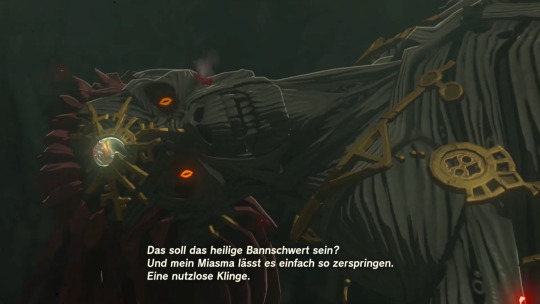
Translation: That is supposed to be the sacred banishing sword? And my miasma shatters it just like that... A useless blade.
English Localization: Was that the sword that seals the darkness? A blade that shatters so easily against my power cannot save you from me.
A few things about this line (and the rest of the scene) under the cut, because I'm gushing. A LOT.
The Master Sword is rarely called Masterschwert (its name in German) in spoken dialogue. I think over the course of the entire game, the Great Deku Tree is the only character to do so, and in Breath of the Wild, only Zelda calls it Masterschwert once. It is, however, called Masterschwert in the inventory, as well as several text-only dialogues.
My hypothesis as to why they did that is that Masterschwert, when spoken out loud, sounds involuntarily comical in German since it comes off as way over-the-top, and can thus destroy an entire, serious scene. Personally, I think heiliges Bannschwert (which I would personally translate as Sacred Blade which Banishes Evil if I were to do a less literal translation, like I did above, into English) is a very fitting title, even though it doesn't sound quite as awe-inspiring if translated into English literally.
Secondly, the gloom is called Miasma in German, which is a historic name for mysterious sicknesses. While not common in contemporary German anymore, you can actually find it in the fantasy genre here and there, including in videogames. German localizers REALLY love to use this term. In comtemporary German, it would be übler Dunst (bad / ill haze), Verunreinigung (pollution / contamination), Befleckung (impurity) or Ansteckung (infection), all of which combined I find to be a really great description of what the gloom is and what it does! Especially considering that the entire reason Link and Zelda decided to investigate it in the first place was because the gloom was making the people of Hyrule sick.
I personally like this line much more than the English one, simply because to me, the English line screams "exposition!!". The German line is also exposition of course, but it does it in a much less subtle way.
Last but not least - let's appreciate Tilo Schmitz, Ganondorf's German VA. The way he delivers this line is spectacular! He makes it sound like Ganondorf is almost a little upset that the Master Sword shattered so easily, while sounding both dark and ancient at the same time. Honestly, I could not imagine a better delivery!

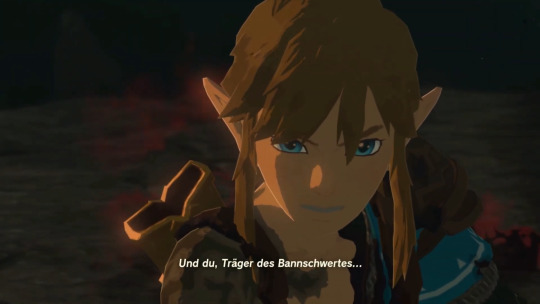
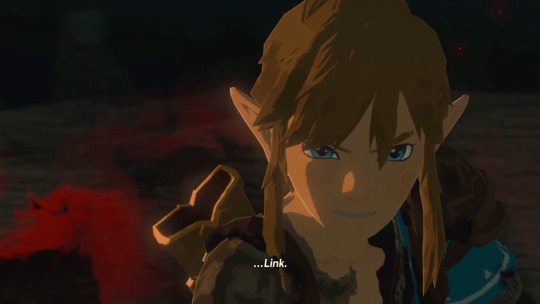
Translation: Zelda... And you, wielder of the banishing sword... Link.
English Localization: Zelda... You who carries the fragile sword... Are Link.
Ganondorf explicitly draws a connection between Zelda and Link in German (not in the romantical sense), which feels much more natural than this kind of jump he does in English.
On a somewhat unrelated sidenote, I like that the camera shows both Zelda's and Link's reactions to Ganondorf knowing their names (unfortunately, I couldn't capture Link's because the subtitle vanishes just before he reacts, and I don't want to overload this post with pics, so... Go watch the scene again 😆). Love that Link has a very obvious reaction too, I feel like he is generally pretty expressive in TotK, which I very much enjoyed!

Translation: Rauru's grand prophecy...
English Localization: Rauru placed his faith in you...
This is an interesting difference to me, because while both lines pretty much mean the same, the connotation (implied meaning) and tone are completely different.
In English, Ganondorf sounds like he is almost blaming Link and Zelda for not fulfilling Rauru's expectations, especially when combined with the next line.
In German meanwhile, this is more of a sarcastic comment, that expresses Ganondorf's disdain of Rauru more than anything else. Tilo Schmitz delivers this line with a very sarcastic undertone as well, making it clear that Ganondorf is, much like in the previous lines, mocking both Link and Zelda, as well as Rauru.

Translation: Two pathetic worms.
English Localization: And that was all that you could do?
Now, there is a big difference! Whereas Ganondorf's line sounds almost like a challenge in English, in German, he is ourtight insulting Link and Zelda.
Also, Tilo Schmitz is amazing as Ganondorf in general, but this is probably my favorite line in the entire game from him. It sounds impactful, it sounds arrogant and despising, it has everything this line should have and more. Most of all, it sounds like he actually means this, and he means it as the character Ganondorf, not just as someone playing Ganondorf (from a meta perspective) or just anyone who can't stand Link and Zelda. It is a perfect line in my opinion, both scriptwise and delivery-wise.
Aaaaand that's pretty much it for this scene! Like in the English localisation, Zelda asks how Ganondorf knows their names (and Julia Casper makes her sound more timid than confused, which I also like very much!).
Anyway, thank you so much for reading 😊 Honestly, I was pretty overwhelmed by the response to my first posting about the German localization of TotK, so I wanted to wait a bit for things to calm down a bit 😅 In the 10+ years I've been on the internet, nothing I've made before has gotten this level of attention. It makes me very happy you guys seemed to enjoy it so much though, and I hope you enjoyed this one as well.
Have a great day, night, whatever time it is when you're reading this, and enjoy the game!
#The Legend of Zelda#LoZ#Tears of the Kingdom#TotK#Localization#German dub#Analysis#Meta#LoZ Analysis#LoZ Meta#TotK Analysis#TotK Meta#Ganondorf#Tilo Schmitz#Link#Zelda#German#Currantlee here#Currantlee translating#Currantlee analyzing
101 notes
·
View notes
Text
I feel like people forget about or gloss over Ganondorf being a genocidal social darwinist to make him sympathetic and it's annoying to me.
Also the problem with Rauru is not that he is secretly evil or an imperialist it's that the writers used problematic standard fantasy tropes uncritically to tell TotK's story and as a result it entirely lacks nuance and has unfortunate implications. TotK's story is just not as interesting as other Zelda games and I wish the writers bothered to break the status quo a little bit.
A fantasy story with a (mostly) good monarchy is always going to be at least somewhat problematic and uncomfortable and I would love to see some actual criticism both from the writers and in-game.
6 notes
·
View notes
Text
I think I'm going to continue missing the more story-focused narratives from other games even if I thoroughly enjoy the open world styles (and find them to be astoundingly innovative), but I have to say, the way Tears of the Kingdom implies so much in its story is absolutely fascinating. so much of it can be missed depending on the order your play or how far out of your way you go for certain quests, but I deeply appreciate just how much you-the-player are left to infer or fill in the gaps to enrich your own interpretation on the story. I love being allowed to read into the subtleties - the music motifs that call back to previous games, side quests that expand on the memories, the voice actor's delivery bringing additional weight and implication to lines of dialogue you might otherwise overlook, even just the current state of the setting compared to it's previous iteration... it's so masterfully done.
#also I keep listening to 'remember this name' and going absolutely bonkers insane so that helps#anyway I have a lot of feelings about the Implications going on between rauru/sonia/zelda/ganon in the past#and I'm going to be Thinking about them for a while#loz#loz meta#totk#tears of the kingdom
23 notes
·
View notes
Text
I've said a couple times on here that I stand by the fact that TOTK isn't rewriting what happened in past Zelda games (specifically Ocarina of Time and Skyward Sword) and I've only just realised that there's more to back this up.
if you read past here and nothing makes sense feel free to ask for clarification <3
How many sages are in Ocarina of Time? Seven.
How many are in TOTK? five.
two sages don't have a counterpart in this new Hyrule, and a whole new sage is added instead.
In Ocarina of Time there are seven sages: Light, Forest, Fire, Water, Shadow and Spirit, with Zelda simply being called "Seventh Sage" and having no defined title
in Totk? there are five: Light, Fire, Water, Lighting and Spirit. Zelda is also seemingly a Sage in totk too, given the title of Sage of Time (I think)
So that's Saria and Impa who have no counterpart as well as a whole new sage being created in TOTK- lightning, that role is taken up by the Gerudo but in Time, the Gerudo take the title of being the Sage of Spirit. Saria/Forest not showing up in TOTK makes complete sense, wouldn't be much sense in having a Regional phenomenon based on Korok Forest & having a Korok sage wouldn't make as much sense as just cutting the Forest Sage completely.
Shadow makes a little less sense to cut, there's the Depths for one, which could easily house a shadow temple (it already houses the Spirit and Fire temple) and with the ring ruins falling in Kakariko village with knowledge of the sages, it'd make sense to have a sage of Shadow be a sheikah like she is in Time.
~~~~~~~~~~~~~
this isn't even the first case of the Sages showing up more than once, In Spirit Tracks the Sages show up as a collective of people from the Lokomo Race, where there are Six of them
They appear in Twilight Princess as a group of Six ghostly men who guard the mirror of Twilight,
and in "Link Between Worlds" there are also Six of them, transformed into paintings by Yuga.
and also wind waker, where things get a little messy since Makar, a Korok is a sage of Wind and Medli is the Sage of Earth.
anyway, Sages appear all over the Zelda timeline with no set race or powers representing them, the only important thing about them is that they all play a role in defeating Ganon/aiding the Hero of Hyrule and the Hylia reincarnate.
#legend of zelda#loz#zelda#tloz#the legend of zelda#loz meta#tears of the kingdom#Legend of Zelda Sages#Loz discussion post#discussion post#Legend of Zelda meta#Loz theory#totk sages#oot sages#ww sages#a link between worlds#Wind Waker#loz a link between worlds#loz botw#breath of the wild#botw#Spirit tracks#legend of zelda spirit tracks
27 notes
·
View notes
Note
hi you seem like a zelda expert
is Link in the wind waker actually not part of the hero's spirit?
i keep seeing so many people saying he is not and it confuses me
Ahhhh okay, this is a bit of a grey area, and subject to interpretation as well, but I’ll try to explain my understanding of it best as I can :) and no shade to anyone who disagrees with me, this is just my understanding of the whole thing.
First off, to understand the whole deal in wind waker, you have to understand first what exactly the deal is with both Ocarina of Time, and the hero’s spirit itself.
In ocarina of time, the Hero of Time draws the Master Sword but is deemed to young to wield it and defeat Ganondorf, so he’s put to sleep for seven years in order to be given time to grow. He wakes up, continues his quest and eventually succeeds in defeating Ganondorf.
Princess Zelda thanks him, and uses the ocarina of time to send Link back to the time before his sleep, seven years back in time so he can enjoy the years he lost. In doing so, Zelda causes a timeline split; Link goes back and stops Ganondorf from taking over, but the time Zelda sent him away from continues on.
The timeline where Link defeats Ganon and is then sent away is what leads eventually to Wind waker’s flood, and the events of the game.
This is why many people believe the Hero of Winds doesn’t have the hero’s spirit. If the previous hero left the timeline, how could his courageous spirit pass on to the next hero? Which leads me to this:
What exactly is the hero’s spirit?
All the different versions of Link are connected by way of all being chosen heroes of the goddess(es), generally wielding the triforce of courage, possessing a commonly referred to as “courageous spirit”, and being able to draw and use the Master Sword. It’s not really a specific thing per say, it’s a mantle almost, an unseen indication of being a Hero of Hyrule.
It’s what Demise cursed to always come back and fight against him.
It’s what makes Link Link, and not just any old guy. It’s unnamed qualities of courage that are a part of him, it’s what made him choose to listen to a voice in his head and rescue a princess from a dungeon, the reason he leapt off of Skyloft, why despite being hurt he chased after the kids he cared about after they’d been kidnapped. It’s what made a kid who’d never been away from his home island chase after the monster that stole away his little sister.
I think in a lot of ways it’s love. Laying down his life for the people and kingdom he cares about, whether it’s family or friends or complete strangers; Link acts out of love, and that’s what the hero’s spirit is.
So to answer your question, I think the Hero of Winds does have the hero’s spirit.
I don’t know if he has the original one, if it somehow hopped timelines and went to him, if he got a new one or what. But the Hero of Winds does have a courageous spirit. He’s the Hero, who fights back against Ganon, who draws the Master Sword, who fights for the people he loves.
If that isn’t the hero’s spirit I don’t know what is.
#legend of zelda#wind waker#loz meta#meta#long post#probably shoulda done a readmore#rambles from the floor#answers from the floor#anon#this of course is pretty subjective so I’m sure others have better and more correct explanations#but this is my understanding of the whole thing#no matter what happens there will always be someone with a courageous spirit to fight evil#I don’t even know if I explained it well I’m tired#but hero of Winds has courage#and that’s all that really mattered in the end
25 notes
·
View notes